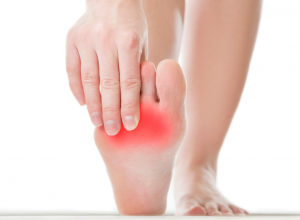
Metatarsalgia
Metatarsalgia, sometimes called a stone bruise, is a condition characterized by pain or inflammation in the ball of the foot. It is usually not a serious ailment and can be easily treated at home with rest, ice and properly fitted shoes.
Symptoms
Metatarsalgia symptoms vary from person to person, but they usually include a sharp, burning pain on the ball of the foot (the pad just below the toes), pain that worsens with standing or during activity, pain or numbness in the toes, and having the feeling that there is a stone or pebble in your shoe. These symptoms can happen suddenly, but usually they develop over a period of a couple of weeks or months.
Causes
There are many causes of metatarsalgia, and several factors often work together to create the painful condition.
Some common causes include:
- Injury or overuse during training or physical activity
- Foot shapes that unevenly balance your distribution of weight
- Foot deformities that cause the foot to be misshapen
- Poorly fitting shoes
- Excessive pronation
- Excess weight that puts pressure on the forefoot and metatarsals
- Morton’s neuroma, which feels similar to metatarsalgia
- Sesamoiditis, which creates pain on the ball of the foot
Metatarsalgia can happen to anyone, but certain activities and conditions can increase your risk of developing the condition. They include participating in athletic activities that put pressure on the feet (tennis, football, baseball and soccer, for example), wearing high heels, wearing shoes that don’t fit properly, and having conditions or disorders that change the shape of your feet (such as foot deformities, bunions, arthritis and gout).
Treatment
Usually metatarsalgia can be treated at home by resting the affected foot, using ice to reduce swelling, and taking over-the-counter pain medications. Sometimes orthotic footwear, metatarsal pads, steroids and physical therapy are recommended for further pain relief and to help speed healing. It is important not to ignore metatarsaliga because if left untreated, it may lead to pain in other parts of the body and an abnormal gait (limping).
In rare cases, orthopaedic surgery may be required to treat metatarsalgia. This usually happens if another condition — hammertoes, bunions, etc. — is causing the pain and swelling.
Notice concerning medical entries:
Articles having medical content shall serve exclusively for the purpose of general information. Such articles are not suitable for any (self-) diagnosis and treatment of individual illnesses and medical indications. In particular, they cannot substitute for the examination, advice, or treatment by a licensed physician or pharmacist. No replies to any individual questions shall be effected through the articles.






